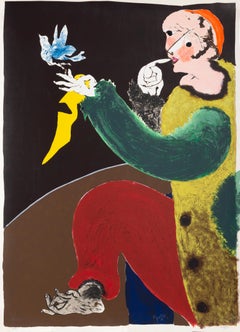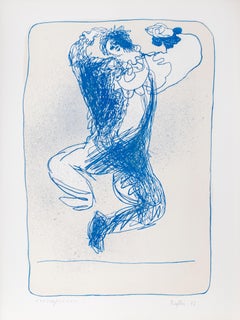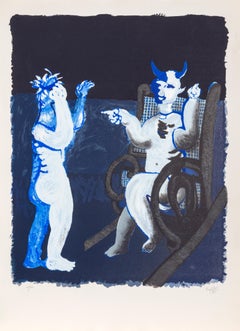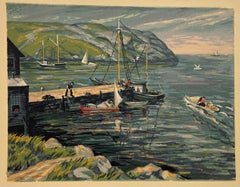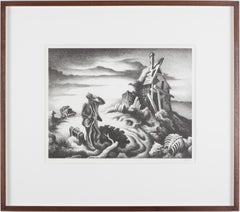Juan Garcia Ripolles Figurative Prints
to
2
1
1
Overall Width
to
Overall Height
to
3
1
22
846
382
380
308
4
1
3
3
1
4
3
2
2
1
1
1
2
2
4
Artist: Juan Garcia Ripolles
Arlequin, Modern Screenprint by Juan Garcia Ripolles
By Juan García Ripollés
Located in Long Island City, NY
Arlequin
Juan Garcia Ripolles, Spanish (1932)
Date: 1981
Screenprint, signed and numbered in pencil
Edition of 75
Size: 41.5 in. x 30.5 in. (105.41 cm x 77.47 cm)
Category
1980s Modern Juan Garcia Ripolles Figurative Prints
Materials
Screen
Harlequin Leaping, Modern Lithograph by Juan Garcia Ripolles
By Juan García Ripollés
Located in Long Island City, NY
Artist: Juan Garcia Ripolles (1932 - )
Title: Harlequin Leaping
Date: 1971
Medium: Lithograph, signed and numbered in pencil
Edition of E.A. XX (20)
Size: 25.5 in. x 19 in. (64.77 cm...
Category
1970s Modern Juan Garcia Ripolles Figurative Prints
Materials
Lithograph
Diablo, Surrealist Screenprint by Juan Garcia Ripolles
By Juan García Ripollés
Located in Long Island City, NY
Artist: Juan Garcia Ripolles
Title: Diablo
Date: 1981
Medium: Screenprint, signed and numbered in pencil
Edition: 45
Paper Size: 33.5 x 27.5 inches
Category
1980s Modern Juan Garcia Ripolles Figurative Prints
Materials
Screen
Un Dia de Marzo, 1981 by Juan Garcia Ripolles
By Juan García Ripollés
Located in Long Island City, NY
Artist: Juan Garcia Ripolles, Spanish (1932 - )
Title: Un Dia de Marzo...
Year: 1981
Medium: Lithograph, signed and numbered in pencil
Edition: 16
Image Size: 14 x 16.5 inches
Size: ...
Category
1980s Expressionist Juan Garcia Ripolles Figurative Prints
Materials
Lithograph
Related Items
Harry Shokler, Island Harbor
By Harry Shokler
Located in New York, NY
Harry Shokler used serigraphy to great advantage in this landscape. It's colorful and detailed.
It is signed in the image at the lower left. When printmakers began making serigraphs...
Category
1940s American Modern Juan Garcia Ripolles Figurative Prints
Materials
Screen
Prodigal Son
By Thomas Hart Benton
Located in London, GB
A man raises his hand to his chin, his neck tilted and face turned to look at a dilapidated farmhouse, barely held together by planks of wood and exposed to the elements. Behind him ...
Category
1930s American Modern Juan Garcia Ripolles Figurative Prints
Materials
Lithograph
Down the River
By Thomas Hart Benton
Located in London, GB
In this sentimental work from 1939, Benton expresses his admiration for the rural lifestyle of the Midwest. He highlights the connection between man and the land by depicting two fig...
Category
1930s American Modern Juan Garcia Ripolles Figurative Prints
Materials
Lithograph
“Winter” from the “Four Seasons Suite” Series
By Alvar Sunol Munoz-Ramos
Located in San Francisco, CA
This embossed, numbered and signed lithograph, part of the “Four Seasons Suite,” is by Alvar Suñol Muñoz-Ramos (b. 1935), a renowned Spanish ar...
Category
1970s Modern Juan Garcia Ripolles Figurative Prints
Materials
Paper, Lithograph
$1,350
H 37.25 in W 30.5 in D 2 in
Discussion
By Thomas Hart Benton
Located in London, GB
In this charming regionalist lithograph, Benton captures a classic Midwestern American scene: two men talking, drinking, and smoking together in a bar. Titled 'Discussion', the artwo...
Category
1930s American Modern Juan Garcia Ripolles Figurative Prints
Materials
Lithograph
"Labor in a Diesel Plant" Machine Age American Scene Industrial Mid 20th Century
By Letterio Calapai
Located in New York, NY
"Labor in a Diesel Plant" Machine Age American Scene Industrial Mid 20th Century
Letterio Calapai (American 1902-1993)
''Labor in A Diesel Plant''
Wood engraving, 1940
17 x 10 1/2...
Category
1940s American Modern Juan Garcia Ripolles Figurative Prints
Materials
Lithograph
$6,900
H 23 in W 16 in D 2 in
Original Mardi Gras New Orleans 1978 festival serigraph poster
Located in Spokane, WA
Original Mardi Gras, New Orleans, 1978 linen-backed poster. Dressed up in what would be an American Indian costume with full headgear, he is holding a shield with a horse on it. Indian decoration on the footwear. Signed and numbered.
I believe this has to deal with Big Chief leading his Congo Nation Mardi Gras Indian group. Zulu Parade. Many of the original Mardi Gras jazz posters...
Category
1970s American Modern Juan Garcia Ripolles Figurative Prints
Materials
Screen
$636 Sale Price
20% Off
H 32 in W 23 in D 0.05 in
Picasso and the Human Comedy, Verve Lithograph Print, 1954 Original lithograph
By Pablo Picasso
Located in London, GB
Picasso and the Human Comedy, Verve, Vol. VIII, No 29/30, 1954
Original lithographs published by Mourlot Frères
Original lithograph print from Verve Vol. VIII, No 29/30 printed by t...
Category
Mid-20th Century Modern Juan Garcia Ripolles Figurative Prints
Materials
Lithograph
$1,341
H 16.15 in W 20.08 in D 0.79 in
Mother And Child
By Romare Bearden
Located in New York, NY
Color screenprint on paper. Signed by the artist in pencil, lower right. Numbered 71/200 in pencil, lower left.
Catalogue raisonne refernece: Gelburd/Rosenberg 59.
Framed d...
Category
1970s Modern Juan Garcia Ripolles Figurative Prints
Materials
Screen, Color
Omegas Død (Omega's Death) /// Edvard Munch Alpha and Omega Expressionist Litho
By Edvard Munch
Located in Saint Augustine, FL
Artist: Edvard Munch (Norwegian, 1863-1944)
Title: "Omegas Død (Omega's Death)"
Portfolio: Alfa og Omega (Alpha and Omega)
*Signed by Munch in pencil lower right
Year: 1908-1909
Medi...
Category
Early 1900s Expressionist Juan Garcia Ripolles Figurative Prints
Materials
Lithograph
$24,000
H 24.13 in W 32.13 in
Ballerine sur fond vert, 1995, original lithograph by Jean Jansem, handsigned
By Jean Jansem
Located in Les Acacias GE, GE
Jean Jansem (1920-2013)
Ballerine sur fond vert, 1995
Lithographie sur papier Arches, justifiée et numérotée 48/100
Signée en bas à droite
22 x 17 cm / 32 x 26 cm
Bibliographie:
...
Category
Late 20th Century Expressionist Juan Garcia Ripolles Figurative Prints
Materials
Lithograph
$358 Sale Price
20% Off
H 12.6 in W 10.24 in
Picasso and the Human Comedy, Verve Lithograph Print, 1954 Oringinal Lithograph
By Pablo Picasso
Located in London, GB
Picasso and the Human Comedy, Verve, Vol. VIII, No 29/30, 1954
Original lithographs published by Mourlot Frères
Original lithograph print from Verve Vol. VIII, No 29/30 printed by t...
Category
Mid-20th Century Modern Juan Garcia Ripolles Figurative Prints
Materials
Lithograph
$1,341
H 16.15 in W 20.08 in D 0.79 in
Juan Garcia Ripolles figurative prints for sale on 1stDibs.
Find a wide variety of authentic Juan Garcia Ripolles figurative prints available for sale on 1stDibs. If you’re browsing the collection of figurative prints to introduce a pop of color in a neutral corner of your living room or bedroom, you can find work that includes elements of purple and other colors. You can also browse by medium to find art by Juan Garcia Ripolles in lithograph, screen print and more. Much of the original work by this artist or collective was created during the 20th century and is mostly associated with the modern style. Not every interior allows for large Juan Garcia Ripolles figurative prints, so small editions measuring 19 inches across are available. Customers who are interested in this artist might also find the work of Antoni Tàpies, Miguel Ibarz Roca, and Barbara A. Wood. Juan Garcia Ripolles figurative prints prices can differ depending upon medium, time period and other attributes. On 1stDibs, the price for these items starts at $600 and tops out at $1,800, while the average work can sell for $975.
